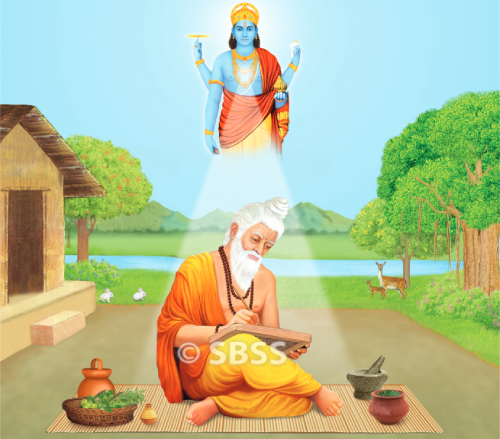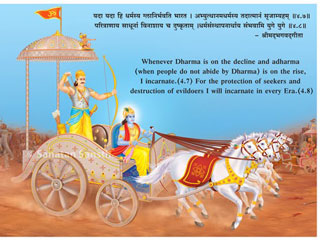Ayurveda for a healthy life ! – 26/2024 on 16.04.2024
To visit earlier link : https://sanatanprabhat.org/english/97342.html

Suppression of biological urges are important causes of several diseases or their symptoms.
1. Suppression of passage of gas through anus
आध्मानशूलौ हृदयोपरोधं शिरोरुजं श्वासमतीव हिक्काम् ।।
कासप्रतिश्यायगलग्रहांश्च बलासपित्तप्रसरञ्च घोरम् ।
कुर्यादपानोऽभिहतः स्वमार्गे हन्यात् पुरीषं मुखतः क्षिपेद्वा ।। – सु. उ.४.७
Suppression of wind that is apana vayu gives rise to colicky pain, constipation and distension. It may occasionally give rise to paralytic ileus and result in mucous, bilious and later faecal vomiting. If chronic, it may result in “gulma” (cystic abdominal lump).
Suppression of this reflex and distended rectum resultsin retention of urine and distension of bladder. Because of distension, it gives rise to hiccups, breathlessness and pain in the cardiac region. If habitual or chronic, by affecting general health, it predisposes a person to develop recurrent cold, cough, pharyngitis, asthma and heart disease. The toxic products after absorption give rise to headache, heaviness of the body, bodyache, exhaustion and diminished clarity of vision.
Treatment
स्नेहस्वेदविधिस्तत्रवर्तयो भोजनानि च ।
पानानि बस्तयश्चैव शस्तं वातानुलोमनम् ।। – च. सू. ७.१३
The patient should be given medicated oil or ghee by mouth and sweating should be induced later. Suppositories and enemas are helpful. The patient should take diet which will enhance normal peristaltic activity of intestines and colon and drink lukewarm water.
2. Suppression of defaecation
पक्वाशयशिरःशूलं वातवर्चोऽप्रवर्तनम् ।
पिण्डिकोद्वेष्टनाध्मानं पुरीषे स्याद् विधारिते ।। – च. शू. ७.८
Suppression of defaecation gives rise to cutting pain in theanorectal region, colicky pain in colon and abdomen, retention of faeces & gases, distension of abdomen, gurgling noises in abdomen, belching and difficulty in passing wind or stools. Occasionally it may result in faecal vomiting or “gulma” which is a cystic type of abdominal lump.
Because of pressure of retained faeces & gases on adjacent organs, it gives rise to retention of urine, breathlessness and pain in the cardiac region. If chronic, it may lead to chronic cold, asthma and heart disease. The waste products after absorption give rise to headache, muscle cramps, bodyache and exhaustion.
Treatment
वर्त्यभ्यङ्गावगाहाश्च स्वेदनं बस्तिकर्म च ।
अन्नपानं च विड्भेदी विधिरानाहिको भवेत् ।। – च. सू. ७
Suppositories and enema are useful. The patient should sit in a tub containing a decoction of drugs, which would subdue vata. The patient should be massaged with oil. This should be followed by induction of sweating. If distension is present, the patient should fast and then vomiting is induced if necessary. Later, the patient should be given light diet like yava (Java), buttermilk, vegetables like vastuka which would also help to split the dry, scybalous, retained faeces. In addition, one should administer digestives and drugs, which would subdue vata & increase secretion of digestive juices. In general, one should follow the treatment of distension of abdomen that is Anaha.
3. Suppression of micturition
बस्तिमेहनयोः शूलं मूत्रकृच्छ्रं शिरोरुजा ।
विनामो वंक्षणानाहः स्याल्लिङ्गं मूत्रनिग्रहे ।। – च. सू. ७
मूत्रस्य वेगेऽभिहते नरस्तु कृच्छ्रेण मूत्रं कुरुतेऽल्पमल्पम् ।। – च. सू. ७
Suppressed micturition gives rise to retention of urine, pain in bladder, penis and testis; distension of lower abdomen and dysuria. The patient may be unable to pass urine due to over-distension of bladder & later develop urinary incontinence. Suppression of the reflex and distended bladder by its pressure effect gives rise to retention of faeces and gases, distension, pain around umbilicus and if chronic may lead to gulma that is cystic abdominal lump like hydronephrosis. Distension may also lead to breathlessness (acidosis), cough, exhaustion and diminished clarity of vision.
स्वेदावगाहनाभ्यङ्गान् सर्पिजश्चावपीडकम् ।
मूत्रे परिहते कुर्यात् त्रिविधं बस्तिकर्म च ।। – च. सू. ७. ७
Tub bath, oil massage, induction of sweating, enemas and bladder wash are important therapeutic measures. The patient should be given Avapeedana sneha that is medicated ghee in good quantity before meals and after the food is digested. One should avoid oil administration orally as til oil gives rise to constipation and oliguria.
Following remedies should be tried for suppressed micturition.
1. Wine should be mixed with milk, cardamom or large quantity of souvarchala salt and taken.
2. The juice of Dhatri or Amalaka (Indian goose berry) diluted with water should be taken daily for 3 days.
3. Cooked meat should be taken with honey and wine prepared from jaggery or grapes.
4. One tola that is 3 teaspoons of compound powder consisting of Bhadradaru, Musta, Murva, Haridra and Yashti-madhu should be dissolved in adequate quantity of rain water and then taken.
5. The expressed juice of Duralabha that is Dusparsha or decoction of Arujna or Saffron should be taken.
6. Seeds of cucumber mixed with a little salt should be taken with water.
7. Panchamoola or dry black grapes cooked in milk are useful.
8. Medicines prescribed for dysuria or bladder stone or obstruction of urine like Shilajatu, Shatavarighruta, Gokshurdi quath are useful.
4. Suppression of vomiting
कण्डूकोठारुचिव्यङ्गशोथपाण्ड्वामयज्वराः ।
कुष्ठहृल्लासवीसर्पाच्छर्दिनिग्रहजा गदाः ।। – च. सू. ७.१४
Suppression of vomiting gives rise to nausea, anorexia, fever, anaemia oedema, cough, breathlessness, eye diseases and skin diseases like Kushtha, Vyanga, Visarpa and Kotha.
Treatment
छर्द्याघातं यदादोषं सम्यक् स्नेहादिभिर्जयेत् ।
सक्षारलवणोपेतमभ्यङ्गं चात्रदापयेत् ।। – सु. उ. ५५.३१
Oil medicated with salt should be used for massaging and medicated ghee should be given internally.
भुक्त्वा प्रच्छर्दनं धूमो लङ्घनं रक्तमोक्षणम् ।
रूक्षान्नपानं व्यायामो विरेकश्चात्र शस्यते ।। – च. सू. ७.१५
Vomiting should be induced after administration of some food. After emesis, the patient should fast for few hours and later take light dry diet. Gargling, smoking cigarettes prepared from herbs having antiemetic action, exercise, purgatives and blood letting are useful therapeutic measures.
5. Suppression of cough
कासस्य रोधात्तद्वृद्धिः श्वासारुचिहृदामयाः ।
शोषो हिध्मा च…. ।। – सं. सू. ५.३७
Suppression of cough results in increased bouts of cough, breathlessness, and hiccup. It also leads to anorexia, emaciation and heart disease (Cor pulmonale).
कार्योऽत्र कासहा सुतरां विधिः ।। – सं. सू. ५.३७
Treatment consists of administration of medicines and measures described for Kasa that is cough.
6. Suppression of sneezing
शिरोतीन्द्रियदौर्बल्यं मन्यास्तम्भार्दितं क्षुतेः ।। – वा. सू. ४.१०
Suppression of sneezing leads to diseases of nose, pharynx, larynx, ears, eyes and head. It gives rise to sense of fullness & pain in the mouth and throat, noisy respiration, headache, hemicrania, weakness of sense organs, stiffness of neck and facial paralysis (following otitis media).
तीक्ष्णधूमाञ्जनाघ्राणनावनार्कविलोकनैः ।
प्रवर्तयेत् क्षुतिं सक्तां स्नेहस्वेदौ च शीलयेत् ।। – वा. सू. ४.१०
Treatment consists of oil massage, administration of medicated oil or ghee, induction of sweating and sneezing. Sneezing is induced by strong nose drops, smoking strong medicated cigarettes, stimulating mucosa of nose by a cotton wick, looking at the Sun, strong eye ointments or snuff with strong smell. The patient should take ghee after meals.
This Indicates the intense study that was done in the field of Ayurveda by Indians.
Contd.

 Radiant Thoughts of Sachchidananda Parabrahman (Dr) Jayant Athavale
Radiant Thoughts of Sachchidananda Parabrahman (Dr) Jayant Athavale Law banning Conversion of Religion is against Individual Freedom : Babbles Former Judge S Muralidhar
Law banning Conversion of Religion is against Individual Freedom : Babbles Former Judge S Muralidhar Editorial : Khalistan, Balochistan and Pakistan
Editorial : Khalistan, Balochistan and Pakistan After India becomes a ‘Hindu Rashtra’, Russia will embrace Hinduism and spread it globally : Nostradamus’ Prophecy
After India becomes a ‘Hindu Rashtra’, Russia will embrace Hinduism and spread it globally : Nostradamus’ Prophecy ‘Halt Public Spending on Aurangzeb’s Tomb, Prioritise Maharashtra’s Heritage’ : HJS
‘Halt Public Spending on Aurangzeb’s Tomb, Prioritise Maharashtra’s Heritage’ : HJS Noise Pollution, Loudspeakers, and the Law
Noise Pollution, Loudspeakers, and the Law